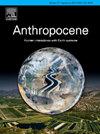Under threat: Land use change, distribution and conservation of poorly-known endemic microsnails from the coast of Chile
IF 3.9
2区 地球科学
Q2 ENVIRONMENTAL SCIENCES
引用次数: 0
Abstract
Mollusks are among the most affected groups in the current extinction crisis, with rates surpassing those of other taxa combined. This is compounded by limited knowledge of many groups and a high proportion of endemic species restricted to small geographic areas. We assessed the vulnerability of six Chilean terrestrial punctoid microsnails by combining species distribution maps with land use, ecosystem, and protected area layers, and by developing semi-quantitative and quantitative vulnerability indices integrating these data with information on habitat, current distributions, and potential future scenarios of climate change and human pressures. We tested the hypothesis that endemic microsnail from the Chilean coast are threatened by the overlap of their distributions with areas of intense anthropogenic pressure, expected to expand under future climate change. Conservation status of species was evaluated using IUCN Red List and NatureServe criteria. Results show significant variation in habitat conditions and threats across species' biogeographical regions. Primary threats encompass habitat loss and fragmentation, wildfires, droughts, and land use changes from urban expansion, agriculture, and forestry, collectively limiting dispersal and increasing vulnerability. Although both climate and composite vulnerability indices vary among species, the former forecasts future exposure to drought and warming, while the latter reflects current ecological traits, anthropogenic pressures, and protection gaps, revealing additional risks and facilitating targeted conservation efforts. Under IUCN criteria, five species qualify as Critically Endangered and one as Endangered. All species are categorized as Critically Imperiled by NatureServe. This assessment underscores the need for habitat protection and sustainable land use in conservation.
面临威胁:智利海岸鲜为人知的地方性微型蜗牛的土地利用变化、分布和保护
在当前的灭绝危机中,软体动物是受影响最大的群体之一,其灭绝率超过了其他分类群的总和。由于对许多群体的认识有限,以及局限于小地理区域的特有物种比例很高,情况更加复杂。我们将物种分布图与土地利用、生态系统和保护区层相结合,并将这些数据与栖息地、当前分布、气候变化和人类压力的潜在未来情景信息相结合,开发了半定量和定量脆弱性指数,对智利6种陆生点状微蜗牛的脆弱性进行了评估。我们验证了这样一个假设,即智利海岸特有的微型蜗牛受到其分布与强烈人为压力地区重叠的威胁,预计在未来气候变化下会扩大。采用世界自然保护联盟红色名录和自然保护区标准对物种的保护状况进行了评估。结果表明,不同生物地理区域的生境条件和威胁存在显著差异。主要威胁包括栖息地丧失和破碎化、野火、干旱以及城市扩张、农业和林业带来的土地利用变化,这些因素共同限制了物种的扩散并增加了脆弱性。气候脆弱性指数和综合脆弱性指数均因物种而异,前者预测未来的干旱和变暖风险,后者反映当前的生态特征、人为压力和保护缺口,揭示额外的风险,促进有针对性的保护工作。根据世界自然保护联盟的标准,五种物种被列为极度濒危物种,一种被列为濒危物种。所有物种都被自然保护区列为极度濒危物种。这一评估强调了生境保护和可持续土地利用的必要性。
本文章由计算机程序翻译,如有差异,请以英文原文为准。
求助全文
约1分钟内获得全文
求助全文
来源期刊

Anthropocene
Earth and Planetary Sciences-Earth and Planetary Sciences (miscellaneous)
CiteScore
6.30
自引率
0.00%
发文量
27
审稿时长
102 days
期刊介绍:
Anthropocene is an interdisciplinary journal that publishes peer-reviewed works addressing the nature, scale, and extent of interactions that people have with Earth processes and systems. The scope of the journal includes the significance of human activities in altering Earth’s landscapes, oceans, the atmosphere, cryosphere, and ecosystems over a range of time and space scales - from global phenomena over geologic eras to single isolated events - including the linkages, couplings, and feedbacks among physical, chemical, and biological components of Earth systems. The journal also addresses how such alterations can have profound effects on, and implications for, human society. As the scale and pace of human interactions with Earth systems have intensified in recent decades, understanding human-induced alterations in the past and present is critical to our ability to anticipate, mitigate, and adapt to changes in the future. The journal aims to provide a venue to focus research findings, discussions, and debates toward advancing predictive understanding of human interactions with Earth systems - one of the grand challenges of our time.
 求助内容:
求助内容: 应助结果提醒方式:
应助结果提醒方式:


